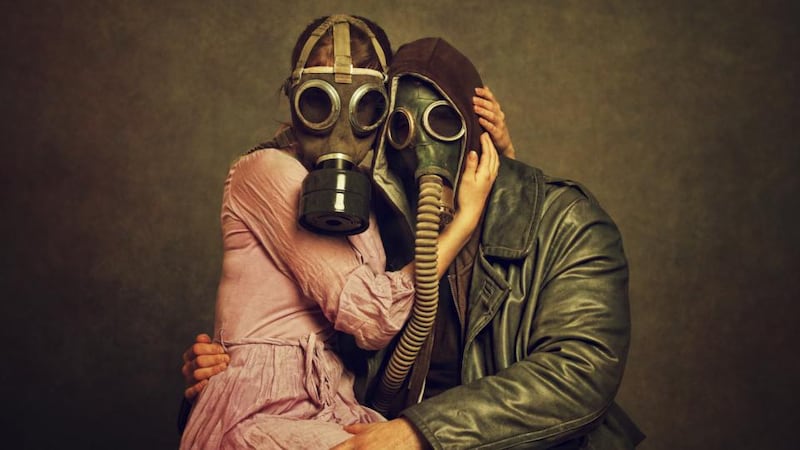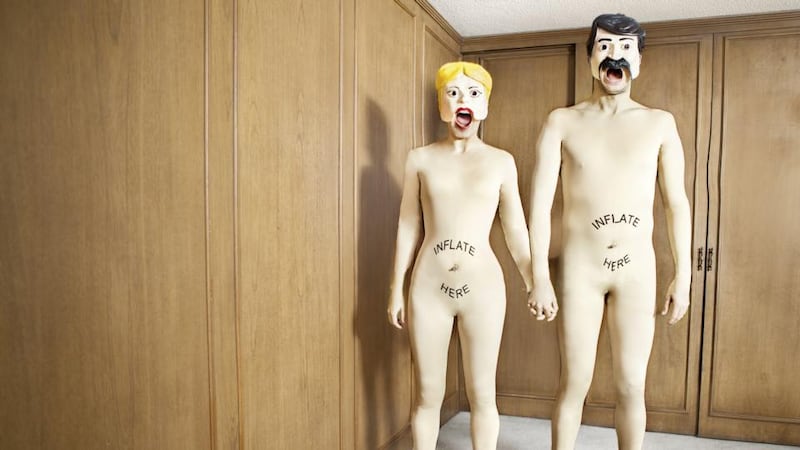What have we here? Is the apocalypse nigh? Does a zombie Chemical Ali roam the Earth? Is this couple overly fond of lentils?
Welcome to life on Planet Getty.
Sheryl Sandberg this week announced she is partnering with Getty Images, one of the world's largest distributors of stock photos. The Facebook chief executive and founder of Lean In wants to change the way women are portrayed in the media. "When we see images of women and girls and men, they often fall into the stereotypes that we're trying to overcome, and you can't be what you can't see."


Hear, hear. But why stop at women?
The Getty creative catalogue is rich with all manner of stereotypes and cliches, depictions of the world that are by turns inappropriate and odd. From construction workers (with the caption “Real Tool Man with work hat”) to twentysomething women (“young woman, 20-25, headshot with taped face”) to “sex doll couple at home, smiling”, no one is safe.
How did it come to this? From around 1880, newspapers and magazines were able to reprint photographs on their pages, replacing line drawings, to illustrate stories. Within the space of a century, the 1980s added its particular brand of farce to the concept of stock photography, as well as opening it up to the amateur photographer out to make a quick buck. And by 1992 the first digital image appeared online. Game over.
If you have a few internet minutes to kill, why not play a game we like to call Being a Subeditor at a National Newspaper. Take one word, maybe two, and type them into Getty’s search engine, then see if your opponent can guess from the image what you were looking for. That sex couple image, for example, came from a search for “senior couple, holding hands”. But that’s not the worst of it for the “Senior Adult”, as they’re known in Gettyburg. When not confused or infirm, the older inhabitants of this parallel universe spend their time looking suspiciously at tablets (prescribed and electronic) or high on life/benzos, dancing at the beach/park.
The life of a stock model is all about extremes.
The worst/best bit is when you need that stock model to do something, such as ballet barre pilates (result: a miserable Mexican luchador wrestler at a bar). Or to feel something, like lasting love (result: a disturbing variety of couples in gas masks) or depression (result: “Boy sits alone on stove with lamp over head”, which, in fairness, is a bewilderingly accurate caption).
Or, most challenging of all, if you need them to look Irish. We’re a people with . . . particular features, and if that’s not something you’ve previously noticed, have a look through Getty for an Irish-looking person that wouldn’t ordinarily be found at the end of a rainbow with a pot of gold (although credit where credit is due for an image titled “Skin burn” depicting the Irish everyman after a day in the sun).
And all that before we get anywhere near Getty’s depraved cousin, Thinkstock. The Beavis and Butthead of stock photography, this site answers every innocent-sounding search with a “that’s what she said” collection of scantily clad women, and men – but mainly women.
But don’t think the internet hasn’t noticed this bizarre world it helped create. Stock imagery has inspired all sorts of entertaining memes, most notably the “Women Laughing Alone with Salad” tumblr. Meta. And rivals to the likes of Getty (and Corbis and Sipa) have grown in number and in strength, attempting to address the industry’s two biggest issues: enabling photographers to earn a decent living, and providing diverse, quality imagery for clients.
When it comes to the latter, Flickr is proving a more and more useful resource for photographs, and Getty thinks so too. In 2008 it entered into an agreement with Flickr tying selected photographers up to its standard exclusive deal, which works out at about 20-35 per cent commission. The collection now numbers more than 600,000 images. And last year, Scoopshot. com">Scoopshot.com was launched. A global platform for uploading mobile photographs, it is essentially an on-demand crowdsourcing site for stock images. More bad news for the beleaguered professional photographer.
While agencies such as Alamy and online communities such as Photoshelter. com">Photoshelter.com offer photographers upwards of 50 per cent commission, the trend is marching on towards micropayment photography and a world of women climbing ladders in stilettos and banging their pretty little heads off glass ceilings.
















